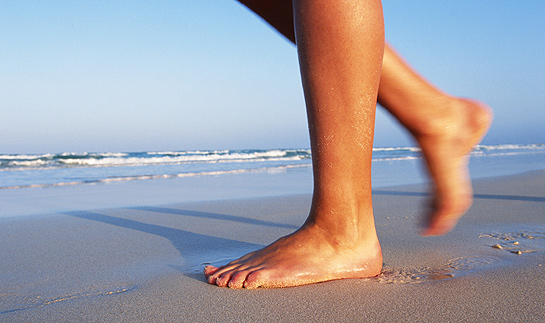It's just so tempting! Beautiful long summer afternoons, and so many amazing beaches to choose from. Who doesn't love a nice long walk to feel the sand between your toes? Or maybe you're making the long trek at low tide to catch yourself a flathead or two! But what do you do when you find yourself suffering with pain when walking, or perhaps the next day? Is the pleasure worth the pain!? Many people complain of painful heels and sore aching feet after spending a relaxing weekend at the beach, so you are not alone.
The foot is an amazing machine, and one that is supported by a multitude of muscles, tendons, and ligaments. When walking barefoot on a soft surface like sand, some of these tissues can take on more stress than they can handle, and they start to tear and then inflame. This inflammation is what you are feeling as pain.
The most common culprit on the under side of the foot is a broad flat structure called the plantar fascia. Inflammation in this is referred to as the dreaded plantar fasciitis (plan-ta fa-cee-i-tis). This is a condition we see in clinic at least half a dozen times every day! A telltale sign of this condition is when you suffer bad pain on the first few steps getting our of bed in the morning.
The Solution
If you haven't been to the beach for some time, it's a good idea to gradually transition to barefoot walking. You should wear supportive thongs on your feet when you're not wearing shoes and in the first few days, limit your bare foot exposure on the soft sand, and then each day gradually increase your walking time on the soft sand. If you are going to go for a very long walk along the beach, it might be worth considering wearing your joggers for the first half of the walk, and go barefoot on the home straight.
What if the pain doesn't go away?
If your foot and heel pain improves each day with a bit of rest and some good footwear choices, then you are probably out of the woods. If it doesn't go away, you have two options. Either walk around in pain for weeks or months (or years). Or you could come and see us for some professional treatment and advice. Depending on how long you have had your pain, the severity of your pain, which structures are injured, and your daily activities, your treatment could range from some basic strengthening, stretching and taping techniques, all the way through to custom orthotic therapy, and more specialised therapies. One word of advice- the longer you leave it, the longer it will take to get better. The sooner we can fix it, the sooner you can get back to normal walking without pain. Sounds good? I bet!



